| Israel's Frog-eating Beetles |
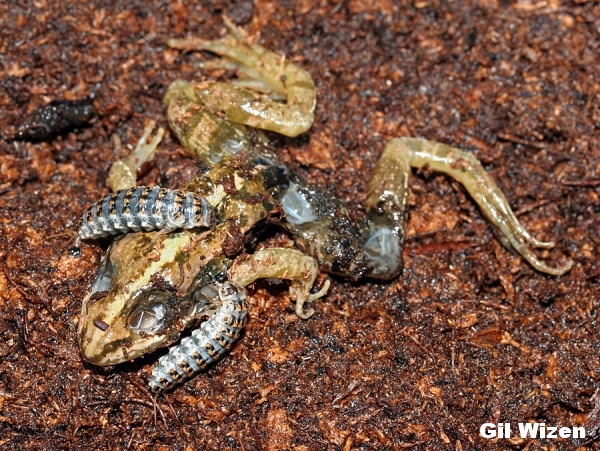 Insects pull a lot of surprising tricks in the game of survival. Parasitic wasps who keep their hosts alive seemingly beyond death, flies that recreate the night sky to lure nocturnal prey, assassin bugs living in partnership with killer plants. By now, nothing should really surprise me when it comes to entomology, but I was just about awestruck when I heard about the recently unraveled predatory habits of Epomis, a genus of Carabid ground beetles whose unusual habits were poorly understood until quite recently. While found as far as Europe and Africa, the beetles are most common (or more accurately, least rare) in Israel, where their dark secrets were unraveled through painstaking research. 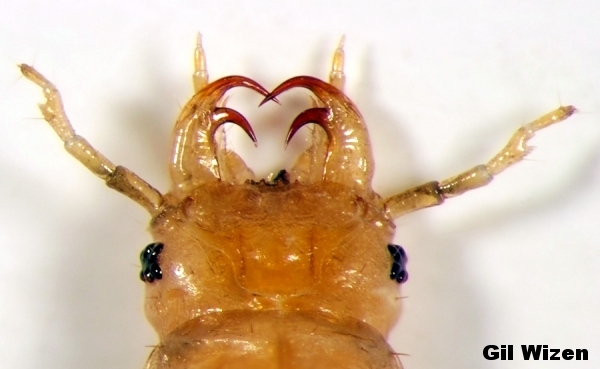
Gil Wizen has spent the last five years studying the highly unconventional hunting behavior of these beetles, and was nice enough to chat with me and send the amazing first-hand photos I'm privileged to be able to share here. He and his colleagues have recently published an extensive scientific paper on their findings, the product of half a decade's observation, collection and testing. While nearly all Carabid beetles are voracious predators in both the larval and adult stages, they usually only prey upon their fellow invertebrates, especially such soft bodied creatures as slugs, snails and caterpillars. The two known species of Epomis, however, have evolved a diet unheard of among insects, having specialized to feed exclusively on a group of vertebrates... vertebrates who have feasted upon their fellow insects since before the dinosaurs walked our planet.
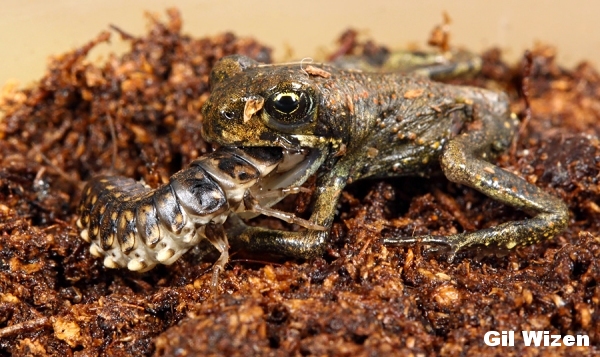
Had it the cognitive capacity for fear as we know it, any other insect would be soiling itself in the above scenario. Frogs are practically nothing but bug vacuums on pogo sticks, bottomless, bulgey-eyed mouths with legs that evolved to slurp up any crawling, squirming little thing that writhes within range of their dextrous and sticky tongues. It's this one-track hunger that Epomis beetles are counting on. In the presence of a frog, toad or even salamander, the Epomis larva begins to wiggle its tiny antennae and jaws, deliberately drawing the attention of its would-be predator. The closer the amphibian, the more urgently the insect beckons. It deliberately makes itself as appetizing as possible to an animal which routinely preys upon its closest Carabid cousins, and when the beast makes its move, its fate is sealed.
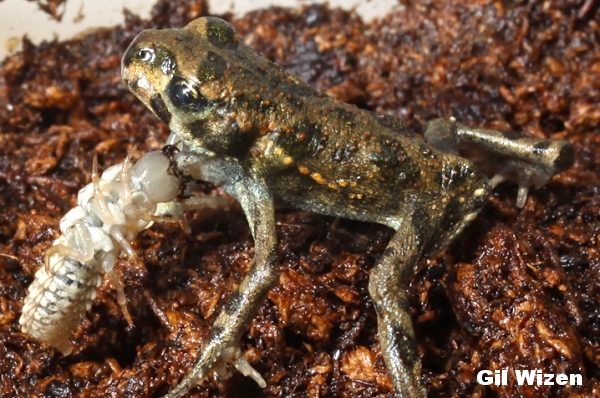
Though the tongue of a frog can lash out and scoop up an insect in just a fraction of a second, Epomis nearly always manages to dodge the attack, swinging its hook-like jaws into its attacker's soft flesh and digging in for a long and gruesome dinner. It begins by sucking blood and other fluids from its catch, but will soon move on to the flesh itself, eating and eating until its far larger prey finally dies and continuing until little remains but a skeleton.
Even in the rare event that a frog does manage to ingest one of these insidious grubs, it has always been observed spitting it back out as the insect attacks sensitive interior tissues. In the experiment above, a larva was even swallowed completely and spent more than two hours in a toad's stomach without succumbing to suffocation or digestive action. "This case was one of the highlights of the study, I think." says Wizen "At the time I didn't have that many larvae in the lab so each one of them was important for the observations. When I saw the larva was completely swallowed by the toad, I immediately thought 'shit! I lost one!' But it was the first time I ever noticed an amphibian prevailing in this interaction, so I kept recording it."
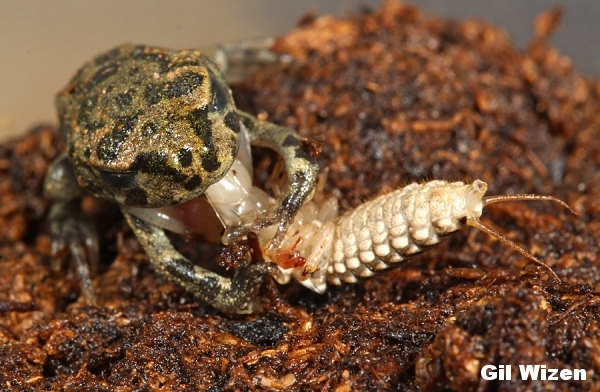
Ow! Ow! Bad idea!
After two hours had passed, the larva was violently regurgitated, stained with blood. It seemed clear that it had continued to attack the toad from within, and subsequently attacked it from the outside once again, killing it in the usual manner. In the hundreds of confrontations observed, the insects have been consistently victorious.
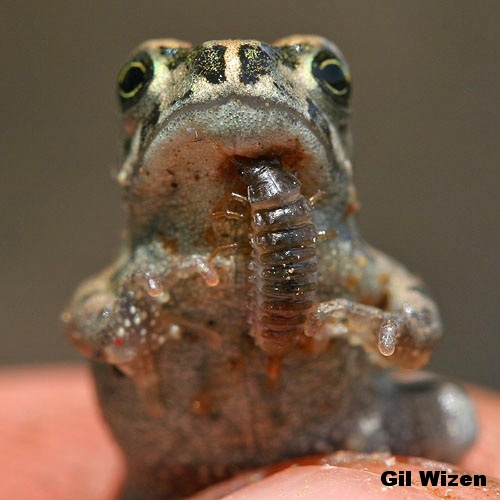
An Epomis larva passes through three main phases, killing only a single amphibian in its first instar but as many as nine in its third. Eventually it pupates and undergoes metamorphosis into a mature ground beetle, but its amphibicide doesn't end there; adults may kill and eat other forms of prey, but have their own special tactic for taking down their favorite childhood treat.
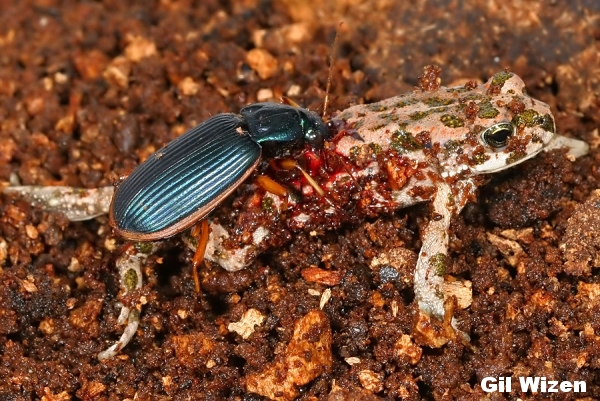
No longer passing themselves off as a tempting meal, the mature beetles simply circle around frogs and attack from behind, sinking their mandibles into the prey's back. Victims sometimes appear to suffer paralysis within minutes, though whether this is a general effect of injury or a deliberate attack mechanism by the beetle is unconfirmed; Wizen recalls when his supervisor was bitten in the finger by an adult and experienced a momentary feeling of numbness, but the insect's jaws have no apparent means of transferring venom or any other compound, nor do the beetles damage the spines of their prey. Regardless, a single small beetle makes short work of even far larger croakers, slowly consuming the bulk of soft tissues.
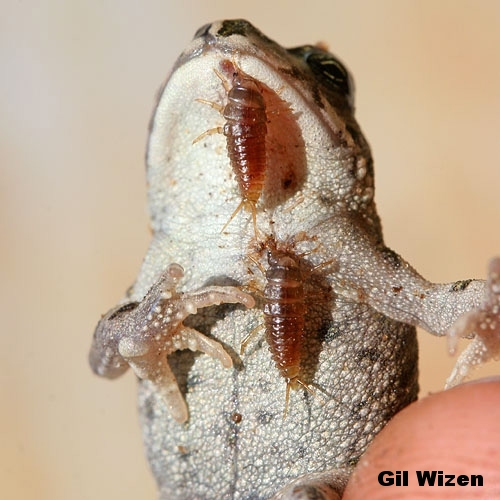
Researching this behavior wasn't easy. For five years, the laboratory became an ironic amphibian hell, with hundreds of croaking little lives sacrificed to prove via rigorous testing that these bizarre insects are indeed specialized amphibian hunters, as Wizen recounts; "I actually love amphibians very much despite how this study may present me. I used to keep pet poison-arrow frogs and salamanders for years. Getting involved in the Epomis study was interesting, but very frustrating. Finding the beetles and the larvae in the field was amazing. Especially during the night, when you get to see them actively preying on amphibians. Throughout these 5 years of study I kept telling myself "I am going to hell for this, no doubt about it" but at least I cracked some of these insects' behavior. I am disappointed that people don't read the paper and then say that all we did was a wrestling match between frogs and beetles."
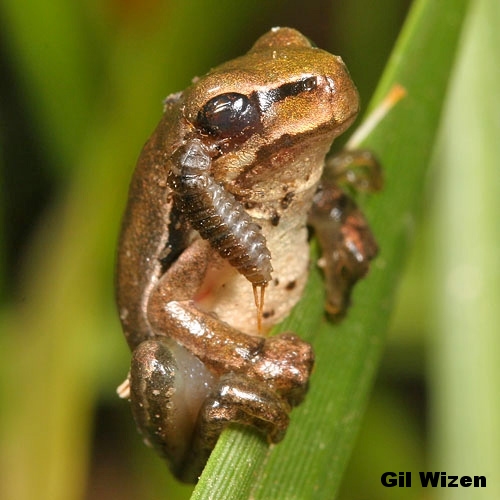
Epomis just goes to show the amazing perseverence of the Insecta. Whether they develop a taste for the innards of their own predators, adapt to harsh climates barren of all other life or rapidly build immunity to the very chemicals we attempt to destroy them with, some insect somewhere on our planet has addressed virtually every problem to face their kind. Push them, and they push back. We can win a thousand battles against these precious little overlords of Earth, but neither man nor frog will ever win the war.
|
| EMAIL ME! |
| blog comments powered by Disqus |